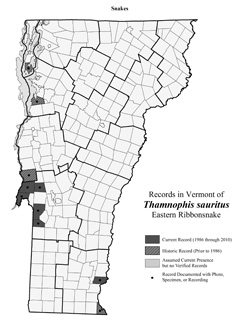Thamnophis sauritus
Eastern Ribbonsnake
Identification
The Ribbonsnake has three yellow, length-wise stripes on a black background. A checkerboard pattern is rarely visible between the stripes. The stripes are well-defined and higher on the sides than in the Gartersnake (scale rows 3 and 4); the scales are keeled. The head is dark reddish-brown over a white upper lip and there is a vertical white bar just in front of the eye. Also look for the mahogany stripe along the lower sides and edges of the belly. The Ribbonsnake is more slender than the Gartersnake. About 1/4-1/3 of its total length is the tail. They may reach 2-3 feet long (the longest documented in Vermont is 35 inches).
Range/Habitat
The Easter Ribbonsnake may be found in pastures, open woods, and rocky areas. They are almost always near water.
Status
This species has a state natural heritage rank of S2. The Eastern Ribbonsnake is rare in Vermont and is a species of special concern. It has been designated a Species of Greatest Conservation Need (high priority) in Vermont’s Wildlife Action Plan.
Please report all sightings of this species in Vermont. Take photos if possible. Even historic sighting information is useful. Before you report a Ribbonsnake, please review these key differences between Ribbonsnakes and Gartersnakes (PDF).
More Info
- Thamnophis sauritus at Animal Diversity website
- Thamnophis sauritus at CARCNET website
- Thamnophis sauritus in the Vermont Agency of Natural Resources’ Wildlife Action Plan (PDF)
- Thamnophis sauritus at the Snakes of Massachusetts website
Species summary written by Kaile Burgess.
In the Media
Bodin, Madeline. 2009. On the Ground: Untangling Ribbon Snakes. Defenders Magazine (84: 2, Summer 2009). Available as podcast at http://www.defenders.org/newsroom/defenders_magazine/spring_2009/on_the_ground_untangling_ribbon_snakes.php
(accessed April 24, 2009; includes article and podcast).


